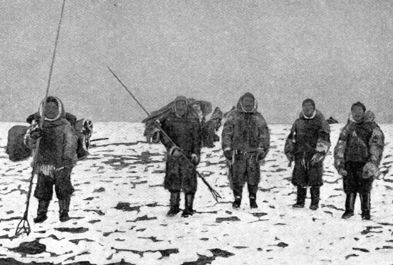“Nechilli Eskimo Equipped for Seal Fishing”

There are about forty men in the party to-day, ranging in age from fifteen to fifty. . . .They proceed in a body over the ridge, but as they approach the ice they deploy in skirmishing order, gradually extending the intervals as they advance, until after a little time their line of march covers a considerable distance. Kachkochnelli presses ahead, humming softly and talking to his dog. There is nothing remarkable abut the dog, neither a particularly high-raised head nor intelligent eyes. . . . Wretched as he is in appearance, I do not suppose his master would exchange him for the finest pointer . . . for he has this merit, which renders him indispensable in these regions, that he knows how to track the seal. Suddenly he darts out on one side, stops and searches the snow carefully, and then lies down flat, leaving the digging operations to Kachkochnelli, who at once probes about in the snow with the “hole-finder,” the same staff he used when testing the snow, with a view to building his igloo. Apparently the very first probings are satisfactory, for he at once slips the strap of his hunting bag over his head, takes the knife from its button, and with it proceeds to remove the layer of snow, covering the hole he has found in the ice. But this is not done without a previous examination (the seal has many holes besides the one he resorts to for breathing), to see whether the hole he has found is really a “breathing hole” still in use, or only an abandoned hole. Kachkochnelli lies down flat on his stomach, in the snow, and smells the hole. His keen sense of smell never deceives him. To-day, fortune favours him; he has struck a genuine “breathing hole,” evidently frequently resorted to by the seal. By a loud shout he intimates to his nearest comrades that he has a “find.” [Amundsen, Vol. 2, pp. 30-32.]